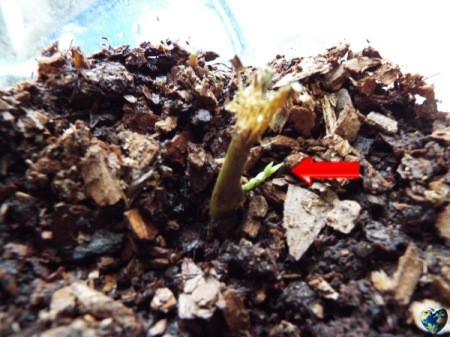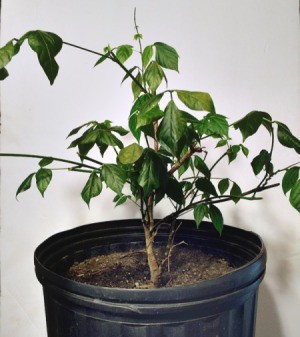
 In an earlier post, I mentioned how expensive Cochliasanthus Caracalla seed were. I bought some, anyway. I mentioned in the post that when I harvested my own seed, I would be more than glad to share with anyone who wanted them.
In an earlier post, I mentioned how expensive Cochliasanthus Caracalla seed were. I bought some, anyway. I mentioned in the post that when I harvested my own seed, I would be more than glad to share with anyone who wanted them.
I spoke too soon. While growing these plants, I learned that they almost never pollinate themselves. Hence, they almost never produce seed, naturally. By the time I learned this, and then learned how to hand pollinate the flowers, it was too late.
I did successfully hand pollinate several flowers and they did produce tiny seed pods. But it was too late in the season for the seeds to mature and ripen before frost.
Not wanting to pay far too much for seed, again, I decided to try overwintering a couple plants. If they survived, I wouldn't have to buy seed, plus I would have some established plants in the spring. That should mean earlier flowering and an earlier chance to hand pollinate the flowers.
I did find a much cheaper source for seed, and as extra insurance I bought another ten ($5.00 & free shipping). They can be purchased on Ebay.
I won't make such a bold statement, again. This time, I will wait and see if I do harvest seed, and if I do, I will then offer them again to fellow ThriftyFun members.
This post is also a follow up on the plants I'm trying to overwinter. First, let me say, these plants have a large root system. My pots were sitting on the ground. When I lifted them to bring them inside, I found that roots had escaped through the drain holes and continued to grow, some as much as five feet. So, if you plan to grow your own and plan to overwinter them inside, do make sure they are in 5 gallon buckets. I had to trim several feet of roots before bringing them in.
The top picture shows one of the plants I brought in. I cut off about 20 feet of vine, leaving about one foot. It sat for two weeks and did nothing. I gave it water. Overnight, it grew two feet! I was shocked, I even told my ag agent about it. Since then, I've had to cut back several inches almost every day. I am confident this plant will make it through the Winter. And as the sunlight is already getting stronger, I will take then outside when the light is bright and the temperature is above forty degrees.
This plant is easily propagated. The bottom picture shows a side shoot I rooted. I forgot about it and the frost killed the top. I brought it inside, anyway. In a few days it produced a tiny side shoot. It too, should make it through the Winter. I will keep you posted.
For those of you who didn't read my earlier post or are not familiar with this exceptionally beautiful and heavily scented flower, here is a link to the post and some nice pictures.
Link: http://www.thriftyfun.com/The-Caracallas-Are-Coming.html

Add your voice! Click below to comment. ThriftyFun is powered by your wisdom!
Since submitting this article for publishing, I have gained more information about overwintering these plants. As I gather new information, I will post it here as comments.
My first addendum is this: I had several plants in pots. I brought them all inside for winter. Not all were treated identically. Some were cut back to 6-8 inches. Some were cut back to the crown.
The ones cut to the crown are not doing too well. Two show no signs of growth and one has a 3 inch sprout arising from the soil.
The ones that were cut back to 6 inches are putting out so much new growth, they must be pruned every 2-3 days.
This monster has been inside for less than three weeks and it is 3 times as large as in the picture. The leaves are quite dark to be growing under artificial light. I hate to keep cutting it back, but if I didn't, I couldn't walk through the house.
Here is one of my Caracallas I brought in for the Winter. I am amazed at how dark green the leaves are while receiving so little indoor light. I will continue to take them out on warm sunny days.
When seed are planted in Spring, you more than likely wont see blooms till late August. My hopes are that by overwintering these plants and taking them out on nice days; I will encourage them to bloom a few months earlier.

And yet another mid winter picture of C. caracalla overwintering inside. I wanted to post this as a chance to emphasize how well these plants are doing under relatively low light. Several feet of runners have been cut from this vine.
If you plan to grow this vine and overwinter it inside but are concerned if you will be able to give it adequate light, I think you can put your apprehensions aside. The plant does quite well in ordinary room light.
It probably would be wise to gradually expose the plant to sunlight when setting outside so as not to burn the leaves.

Something I haven't seen anyone else mention yet is starting these from cuttings. I absolutely LOVE these plants and didn't want to lose them to winter. I had read this page already and brought in the ones that were in pots, but the day we got our first frost warning, I went outside and cut all the vines from the plants that were in the ground. Because I was working against daylight and temperature, I ended up with a bathtub full of seven foot vines (the four plants easily had thirty feet of vine apiece). Then, over the next week, I lopped them off at about six inch intervals (I cut them right above a leaf at a forty-five degree angle, dipped the end in cloning hormone, and stuck them in peat pods--each cutting ending with a leaf). Several weeks later, I have a success rate of about 70% and currently have 226 rooted, potted clones in my office.
Add your voice! Click below to comment. ThriftyFun is powered by your wisdom!